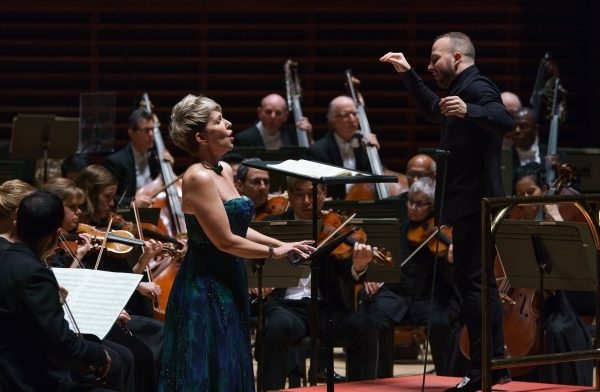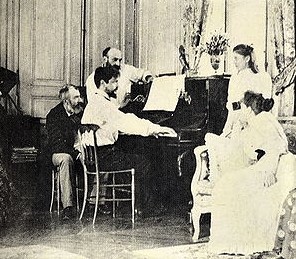
Philadelphia Orchestra plays music by Wagner, Bates, Chausson and Respighi, November 8-10, 2018 at the Kimmel Center in Philadelphia.
This was a concert where all of its four compositions were major events.
One was the Philadelphia premiere of a colorful work by one of today’s outstanding young composers, Mason Bates, newsworthy in its own right. Then there was the guest appearance of opera star Joyce DiDonato, which deserves headlines. Even the two other compositions, mainstream pieces, had exceptional elements.
Bates’s Anthology of Fantastic Zoology proves that contemporary music can be crowd-pleasing while it also is academically accomplished. This was commissioned by Riccardo Muti and the Chicago Symphony in 2014 and was receiving its Philadelphia debut. It’s a symphonic incarnation of characters created by the Argentinean poet Jorge Luis Borges, a master of magical realism and narrative puzzles whom Bates encountered when an English major at Columbia twenty years ago. The eleven interlocking movements are a compendium of mythological creatures.
Like the animals, Bates’s score is imaginative and colorful. His “Sprite” hops from music stand to music stand, even bouncing offstage. As Bates said, “Why can’t we have a riff whip through the section in an almost visual way?“ The imaginary “A Bao A Qu” is a serpentine creature that slithers up a tower, then slides back down in a musical palindrome. “The Zaratan” is an island-sized animal conjured by tone clusters. Massed tympani are prominent downstage. Unlike some other Bates compositions, Fantastic Zoology does not include electronics, but it has unusual, exciting musical effects.
There’s a tendency for some musically-educated sophisticates to admire music that eludes (or bores) ordinary listeners. Examples: recent operas by Nico Muhly and Thomas Adès. Yannick Nézet-Séguin, because of his position in opera circles, knows well that Verdi and Wagner earned their stature because audiences — not just some connoisseurs — loved what they heard. Therefore I hail this Bates piece and hope to hear more of his music. Paraphrasing what the composer says, why shouldn’t new music put a priority on bringing pleasure to listeners?
DiDonato returns to where she studied at the Academy of Vocal Arts to make her Philadelphia Orchestra debut after years as a world-respected mezzo. She and Nézet-Séguin chose a lovely piece by Ernest Chausson that’s too rarely performed. His song-cycle Poème de l’amour et de la mer (Poem of Love and the Sea) is filled with melancholy imagery of the sea, the sky, lilacs, and dead leaves blowing in the wind. The saddest song is about the coming of Spring when there are no blossoms. Lilacs and roses, and love, are dead forever (est mort à jamais.)
It reminds me of the song with words and music by Frank Loesser, “Spring will be a little late this year…for you have left me, and where is our April of old?” Especially poignant is the Chausson setting of the word “l’oubli” (forgotteness) because nothing is more sad than the realization that one’s ex doesn’t even remember the love that once existed.
Dressed in a form-fitting forest green and navy strapless gown with sequins, DiDonato used subtle degrees of color to reflect the emotions of the Poème. She reflected despair by reducing vibrato to a bare minimum at appropriate moments. Lovely bassoon and cello solos by Daniel Matsukawa and Hai-Ye Ni stood out as Nézet-Séguin led a lush rendition of Chausson’s score. The composer blended influences by the unlikely combination of Wagner and Debussy, and Yannick picked up on this fact in his choice of the program’s opener.
The unfortunate Chausson died when only 44 years old in a bicycle accident. His funeral was attended by his friends Debussy, Duparc, Fauré, Albeniz, Edgar Degas and Auguste Rodin and he was buried in Père Lachaise Cemetery in Paris.
Nézet-Séguin led the entire program without baton. He started with the soft, ethereal sounds of Wagner’s prelude to Lohengrin and closed with Respighi’s The Fountains of Rome. Less-frequently heard than his The Pines of Rome, it’s more subtle, quieter; less splashy you might say if you’ll forgive the bad pun. The common theme of the day was tone-painting, sometimes restrained and at other moments full-throated.
Below, Chausson turning pages for Debussy in 1893:
